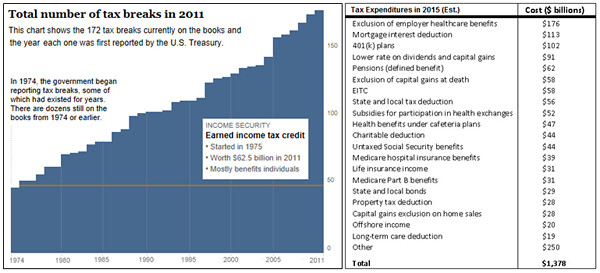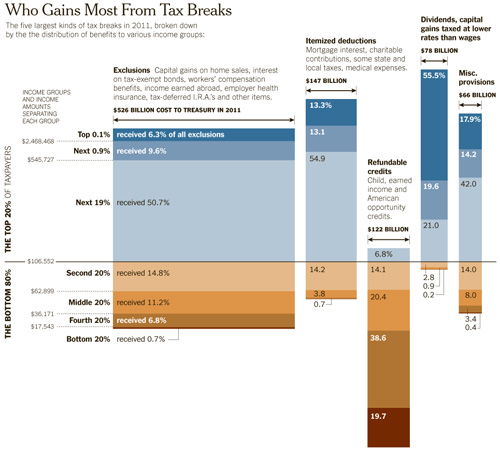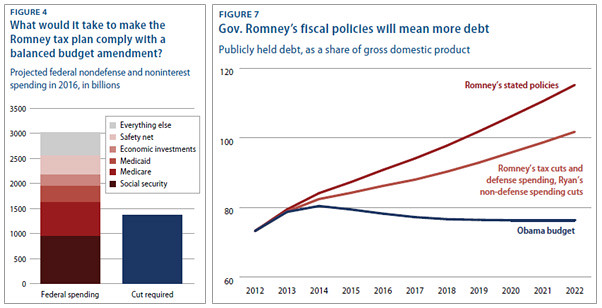Introducing his new running mate on Saturday, Republican presidential nominee Mitt Romney boasted, "We offer solutions that are bold, specific, and achievable." Number Two dutifully followed Number One, as Paul Ryan then promised voters, "We won't duck the tough issues...we will lead."
Just not, it turns out, when it comes to the central premise of the Romney-Ryan economic plan. Both men have pledged to lower tax rates and "broaden the base" by closing some of the myriad deductions and loopholes that cost the United States Treasury over $1 trillion a year in lost revenue. But because neither man has "the courage to tell you the truth" in "the light of day," which tax expenditures they will close--and which Americans be hit hardest--will be a mystery until after Election Day. The result is that the ersatz Republican deficit hawks will add trillions more to the national debt than the Democrats they want to replace while raising the tax bill on working families.
While Governor Romney has stopped short of fully adopting the Ryan House Republican budget he has called "marvelous" and repeatedly pledged to sign if it crossed his desk, their respective blueprints are nearly identical on the issues that matter most. Both Ryan and Romney would deliver a massive tax cut windfall for the rich, a multi-trillion giveaway offset only in part by gutting the social safety net each pretends to protect. Romney-Ryan ends Medicare as we know it with a "premium support" gambit that would dramatically shift health care costs to America's seniors. Their shared call for repealing the Affordable Care Act could leave up to 48 million more people without health insurance. Even as their draconian austerity budgets would increase unemployment beginning in 2013, both men would nevertheless ratchet up defense spending. And despite their mutual pledges to end many tax loopholes and deductions to fund their gilded-class giveaway, Romney and Ryan are too cowardly to say which ones. As a result, these supposed deficit hawks would actually add trillions more in red ink to the national debt.
As it turns out, there's a simple problem with Ryan's bragging that his plan will "prevent an explosion of debt from crippling our nation and robbing our children of their future." That is, his math doesn't work. As the Washington Post's Ezra Klein explained in March, Ryan has a roughly $6 trillion hole to fill:
The Tax Policy Center looked into the revenue loss associated with House Budget Chairman Paul Ryan's plan to cut the tax code down to two rates of 10 percent and 25 percent. They estimate the changes would raise $31.1 trillion over 10 years, or 15.4 percent of GDP. That's $10 trillion less than the tax code would raise if the Bush tax cuts were allowed to expire, and $4.6 trillion less than it would raise if all of the Bush tax cuts were extended.
The Republican congressman says he'll "broaden the tax base to maintain revenue...consistent with historical norms of 18 to 19 percent." So let's say Ryan needs to find close-enough deductions and loopholes to hit 18.5 percent of GDP. That means he'd need to close about $6.2 trillion in tax deductions and loopholes over 10 years.
But so far, Rep. Ryan has refused to answer the $6 trillion question: which tax deductions and loopholes will he close? And as we'll see below, he's not the only refusenik on the GOP's 2012 ticket.
As the Washington Post showed (chart above), the trillion-plus dollars in annual tax expenditures is now larger than Uncle Sam's take from the income tax each year. And as the Post also highlighted last year, "ever-increasing tax breaks for U.S. families eclipse benefits for special interests."
It's important to understand that much of the estimated $1.3 trillion in annual tax expenditures in 2015 (a figure larger than the entire 2012 budget deficit and equivalent to about a third of the $3.8 trillion in federal spending next year) benefit working and middle income Americans. For example, the home mortgage tax deduction was worth $89 billion in 2011. Tax-deferred 401K accounts cost the Treasury $63 billion. The Earned Income Tax Credit had a similar $63 billion price tag last year.
So what deductions and loopholes are actually in the mystery meat that is Paul Ryan's budgetary dog food? As Paul Krugman explained in "Pink Slime Economics":
We're talking about a lot of loophole-closing. As Howard Gleckman of the nonpartisan Tax Policy Center points out, to make his numbers work Mr. Ryan would, by 2022, have to close enough loopholes to yield an extra $700 billion in revenue every year. That's a lot of money, even in an economy as big as ours. So which specific loopholes has Mr. Ryan, who issued a 98-page manifesto on behalf of his budget, said he would close?
None. Not one. He has, however, categorically ruled out any move to close the major loophole that benefits the rich, namely the ultra-low tax rates on income from capital. (That's the loophole that lets Mitt Romney pay only 14 percent of his income in taxes, a lower tax rate than that faced by many middle-class families.)
As Matthew Yglesias pointed out, in Ryan's 13-page description of his tax reform vision, those politically tough choices are completely missing:
Thirteen pages dedicated to explaining his vision for revenue-neutral tax reform. And even so he manages to not name a single tax deduction that he's planning to eliminate. Home mortgage interest deduction? I dunno. Electric vehicle tax credit? I dunno. Deductibility of state and local income taxes? I dunno.
Ryan has admitted as much. Appearing on MSNBC's "Morning Joe" on March 20th, Congressman Ryan declared he would "Get rid of the special interest loopholes, special deductions, lower everybody's tax rates, bring in at least as much revenue to the government but grow the economy and create jobs, and get spending under control so we can pay off this debt." But when host Joe Scarborough asked "Which one of those [loopholes] do you eliminate," Ryan decided discretion was the better part of valor (starting around the 1:15 mark):
"We want to do this in the light of day and in front of everybody. So the Ways and Means Committee, which is in charge of the tax system, sent us the plan here, which is a 10 and 25 percent bracket for individuals and small businesses, and then they want to have hearings and, in light of day, show how they would go about doing this."
Appearing on CBS Face the Nation just days later, Ryan again claimed that "We're proposing to keep revenues where they are, but to clear up all the special interest loopholes, which are uniquely enjoyed by higher income earners, in exchange for lower rates for everyone." But he once again pleaded the Fifth when asked which "special interest loopholes" he would do away with:
"That's what the Ways & Means Committee is supposed to do. That's not the job of the Budget Committee," Ryan said on Fox News Sunday. "What we're saying is, we want to do this in the light of day, not in some backroom deal. We want to have hearings in the Ways & Means Committee that Chairman Dave Camp has already started that work, to say what tax benefits should go."
For his part, Ryan has claimed - but not detailed how - he would leave "middle-income tax write-offs" in place. Instead, he told ABC's This Week earlier this year, "With respect to the wealthy, we're saying, 'Stop subsidizing the wealthy. Close the tax shelters and loopholes that are disproportionately used by the wealthy so that we can get more tax revenue by having a broader tax base with lower rates.'" As Fox News dutifully reported:
But Ryan argued that popular deductions might not have to be eliminated for everybody -- just the high-income earners who "disproportionately" use them. He indicated a willingness to end the home mortgage interest deduction and other breaks for top earners...
Ryan said it's "impossible" to know whether the wealthy would end up benefiting more or less from all these changes.
Actually, it's not impossible. Looking at Mitt Romney's similar proposals, the nonpartisan Tax Policy Center did just that. And the results are hardly surprising.
Even after assuming the closure of tax loopholes and deductions which disproportionately favor the rich, TPC forecast that President Romney would cut taxes for the richest five percent of earners while increasing the tax bill for the other 95 percent of Americans. It's no wonder Ezra Klein concluded that "'broadening the base and lowering the rates' is anti-family tax reform," adding:
"The size of the tax cut he's proposing for the rich is larger than all of the tax expenditures that go to the rich put together. As such, it is mathematically impossible for him to keep his promise to make sure the top one percent keeps paying the same or more."
For months, Mitt Romney has been using the same dodge as Paul Ryan, promising only that the "1 percent keeps paying the current share they're paying or more." In March, economic adviser Glenn Hubbard confirmed Romney's cowardice, explaining "it is not his intention to take on any specific deduction or exclusion and eliminate it." As the New York Times reported:
"In order to limit any impact on the deficit, because I do not want to add to the deficit, and also to make sure we continue to have progressivity in our tax code, I'm going to limit the deductions and exemptions, particularly for high-income folks," Mr. Romney, a former governor of Massachusetts, said. "And by the way, I want to make sure that you understand, for middle-income families, the deductibility of home mortgage interest and charitable contributions, those things will continue," he said. "For high-income folks, we are going to cut back on that, so we make sure that the top 1 percent keeps paying the current share they're paying or more. We want middle-income Americans to be the place we focus our help, because it's middle-income Americans that have been hurt by this Obama economy."
But just two weeks later, Mitt Romney chickened out again, refusing to reveal which deductions and tax breaks he would end:
"So I haven't laid out all of the details about how we're going to deal with each deduction, so I think it's kind of interesting for the groups to try and score it, because frankly it can't be scored, because those kinds of details will have to be worked out with Congress, and we have a wide array of options."
In response, the Post's Klein could only shake his head:
"Let's be clear on this: A tax plan that can't be scored because it doesn't include sufficient details is not a plan. It's a gesture towards a plan, or a statement of intended direction, or perhaps an unusually wonky daydream. But it's not a plan."
Well, it is a plan in one sense. That is, unless they reveal their loophole closing secret sauce, President Romney and Vice President Ryan will produce red ink as far as the eye can see.
As the Center for American Progress explained, the Congressional Budget Office (CBO) assessment of the Ryan budget "did not test Rep. Ryan's claims about how his policies would actually affect spending or revenue," but "merely showed what would happen to the debt if his claims were true." In a nutshell, they are not:
But the House budget's entire claim to deficit reduction is built on the foundation of those fantasy revenue levels. Without them, the debt goes up, not down. In fact, with all the House budget's tax cuts properly accounted for, revenue would average just 15.3 percent of GDP from 2013 through 2022, not 18.3 percent. The result: deficits would never drop below 4.4 percent of GDP, and would rise to more than 5 percent of GDP by 2022.
The national debt, measured as a share of GDP, would never decline, surpassing 80 percent by 2014, and 90 percent by 2022. By comparison, President Barack Obama's budget proposal, released in February, would stabilize the debt by 2015, and bring it down to 76 percent by 2022.
If this all sounds familiar, it should. Because in February, Mitt Romney also rolled out a new economic plan, one which similarly hemorrhages red ink.
As it turns out, Romney's scheme to "Cut, Cap and Balance" the federal budget does nothing of the sort. As the Washington Post explained in its discussion of an analysis by the Committee for a Responsible Federal Budget, "until the campaign offers a more specific plan, Budget Watch analysts said Romney's entire framework would add about $2.6 trillion to the debt by 2021." (As ThinkProgress and the Washington Post's Lori Montgomery and Ezra Klein all explained, that's likely a conservative estimate.)
In words and in pictures (above), CAP put it this way:
The various fiscal promises Gov. Romney makes simply cannot work together. He cannot simultaneously cut taxes as he's proposed, increase defense spending, protect Social Security and Medicare for current and near-future retirees, and also balance the budget. It is mathematically impossible.
Mathematically impossible and, for the American people, catastrophic.
Such is price of cowardice. For his part, Mitt Romney during brief moments of candor has acknowledged his complete lack of political courage. As the former Massachusetts Governor inadvertently revealed in an interview with the Weekly Standard, his opacity is by design, a lesson learned from losing the 1994 Senate race:
"One of the things I found in a short campaign against Ted Kennedy was that when I said, for instance, that I wanted to eliminate the Department of Education, that was used to suggest I don't care about education," Romney recalled. "So I think it's important for me to point out that I anticipate that there will be departments and agencies that will either be eliminated or combined with other agencies. So for instance, I anticipate that housing vouchers will be turned over to the states rather than be administered at the federal level, and so at this point I think of the programs to be eliminated or to be returned to the states, and we'll see what consolidation opportunities exist as a result of those program eliminations. So will there be some that get eliminated or combined? The answer is yes, but I'm not going to give you a list right now."
In a December profile by the Wall Street Journal, Governor Romney acknowledged that when it comes to facing the voters, his cowardice is a feature, not a bug:
Amid such generalities, it's hard not to conclude that the candidate is trying to avoid offering any details that might become a political target. And he all but admits as much. "I happen to also recognize," he says, "that if you go out with a tax proposal which conforms to your philosophy but it hasn't been thoroughly analyzed, vetted, put through models and calculated in detail, that you're gonna get hit by the demagogues in the general election."
But what Mitt Romney calls "demagogues," most Americans would call "voters." And they can handle the truth. Mitt Romney and Paul Ryan simply too afraid to give to them.



















